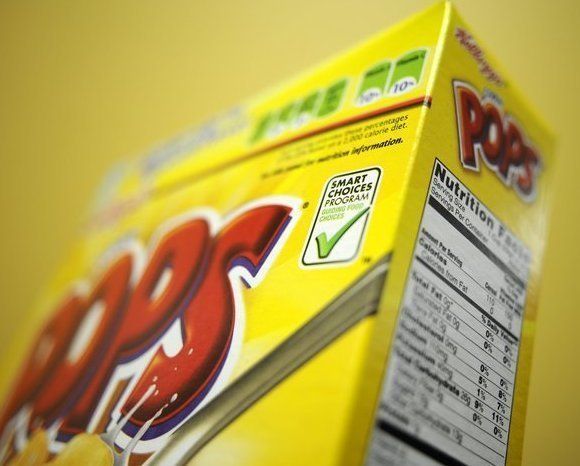
Last week, the FDA hinted it would be seriously looking at regulating Front of Pack (FOP) nutrition labeling systems. As a result, Smart Choices called it quits, and other programs are "on alert". The FDA's involvement can be of great assistance to the public, by creating a single unified system in all supermarkets and on all packages.
But first, wouldn't it be nice if the FDA cleaned up the mess originally created when the Nutrition Labeling and Education Act (NLEA) brought us the nutrition facts label as we know it today?

Here's a list of 10 things the FDA can do to improve the existing information on labels.
1. Real serving size. Have you ever noticed the ridiculously small serving sizes on packages -- 3 Oreos? 15 potato chips? Or a single serve 20 fl oz bottle of cola written up as containing 2.5 servings? Manufacturers like to minimize the servings to toddler size portions so that the nutrition facts per serving won't seem too bad (calories, sugar, etc ... ). This is misleading and needs to change to reflect how people really consume food and drink.
2. How much sugar? Currently there is no FDA defined level of maximum daily consumption of sugar. People don't know if 27 grams of sugar is a big chunk of their daily allowance or not. For sodium, fats, and vitamins, the "percent of daily value" (DV) clearly lets you know if you're getting a low or high amount. The World Health Organization (WHO) recommends at most 125 grams of total sugar per day.
3. How much added sugar? The nutrition label states the amount of total sugar in a serving, but it does not indicate whether the sugar is added to the food, occurs naturally, or both. Caloric-ly, there is no difference between added sugar and sugar found naturally in fruits and vegetables. But the benefit of fruits containing naturally occurring sugars is in the additional vitamins, minerals, fiber, antioxidantss and phytochemicals they provide. Added sugars provide no health benefits. They are truly empty calories. People should choose products with as little added sugar as possible. Unfortunately, today consumers can only guess how much sugar has been added to a product.
4. Zero should be zero. Did you know that if a product contains trans fat, but less than 0.5 grams per serving, it can legally be labeled as 0 gram of trans fat? This is ridiculous. Serving sizes can be "calibrated" to be just under half a gram's worth of trans-fat and receive the coveted zero number. But when wolfing down a snack bag (real serving size much larger than labeled - see point #1), you could be getting even 1.25 grams of trans-fat, all while thinking that the product contains none at all.
5. No more qualified health claims. The FDA allows manufacturers to place health claims on products based on sound scientific evidence. But in the past few years, allowances for limited research has become acceptable, as long as the claim is "qualified" with mouse print disclaimers elsewhere on the package (usually a tiny font at the bottom). This does not serve consumers' best interest and creates a false halo of health in paces it should not.
6. Caffeine content. Products that contain caffeine should clearly state the amount. People are often surprised to discover caffeine in soft drinks, cakes, and other snack items. Some energy drinks contain ridiculously high amounts. Physicians have asked the FDA to require caffeine labeling on energy drinks.
7. Better allergy and intolerance info. More than 30 Millions Americans suffer from some sort of allergy or food intolerance. Although the presence of the 8 major allergens is clearly stated by law, there are fuzzy areas. For example, when a plant manufactures a product without peanuts, but uses a production line that processes peanuts as well, there is no clear wording to consumers. The FDA is working on this.
8. Allow rBGH-free labels. rBGH / rBST is a hormone injected into cows to increase their milk output. The hormone has been associated with various health risks for humans consuming the milk. Bowing to industry pressure in the 1990's, the FDA required manufacturers who chose not to use milk from rBGH cows and put that information on the label to also state that that there is no significant difference between rBGH and rBGH-free dairy. (Thanks Rick North, comment #3 below, for the clarification on this matter).
9. Label Booz. Alcoholic beverages should be labeled as well. At a bare minimum, provide serving size and calories.
10. Lastly, Front of Package Labeling. We'd like to see the FDA put out a program that addresses not just the positive aspect of a product but also its negatives. Low fat is fine and dandy, but not at the cost of doubling the sugar count. The UK's Traffic Light system has been shown to be easily understood by consumers. It is also really ticking off manufacturers. That must mean it's good.
To summarize, with all the attention and public outcry over nutrition labeling, the FDA has a great opportunity to not only decide on the front of package labeling, but also fix the historical loopholes and problems of the existing nutrition facts panel.
What to do at the supermarket:
Until the FDA sorts out this mess, your best bet is to ignore existing front of package information and spending a few extra moments scanning the nutrition panel and ingredient lists. In general, healthier products have short, understandable ingredient lists, and are low in saturated fat, sodium, and sugar.